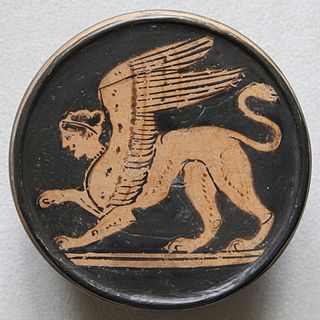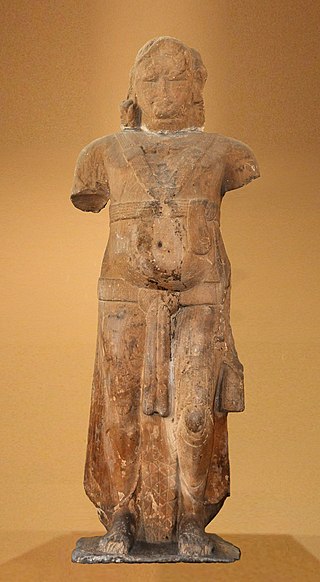
Garuda is a Hindu deity who is primarily depicted as the mount (vahana) of the Hindu god Vishnu. This divine creature is mentioned in the Hindu, Buddhist and Jain faiths. Garuda is also the half-brother of the Devas, Gandharvas, Daityas, Danavas, Nāgas, Vanara and Yakshas. He is the son of the sage Kashyapa and Vinata. He is the younger brother of Aruna, the charioteer of the Sun. Garuda is mentioned in several other texts such as the Puranas and the Vedas.

A sphinx is a mythical creature with the head of a human, the body of a lion, and the wings of an eagle.

Rākshasas are a race of usually malevolent beings prominently featured in Hindu mythology. They reside on Earth but possess supernatural powers, which they usually use for evil acts such as disrupting Vedic sacrifices or eating humans.

In Buddhism, wrathful deities or fierce deities are the fierce, wrathful or forceful forms of enlightened Buddhas, Bodhisattvas or Devas ; normally the same figure has other, peaceful, aspects as well. Because of their power to destroy the obstacles to enlightenment, they are also termed krodha-vighnantaka, "Wrathful onlookers on destroying obstacles". Wrathful deities are a notable feature of the iconography of Mahayana and Vajrayana Buddhism, especially in Tibetan art. These types of deities first appeared in India during the late 6th century, with its main source being the Yaksha imagery, and became a central feature of Indian Tantric Buddhism by the late 10th or early 11th century.

Vaiśravaṇa or Vessavaṇa, is one of the Four Heavenly Kings, and is considered an important figure in Buddhism. He is the god of warfare and usually portrayed as a warrior-king.

The Four Heavenly Kings are four Buddhist gods or devas, each of whom is believed to watch over one cardinal direction of the world. In the Sanskrit language of India, they are called the "Caturmahārāja" (चतुर्महाराज) or "Caturmahārājikādeva": "Four Great Kings". In Chinese mythology, they are known as "Sì Dàtiānwáng" or collectively as "Fēng Tiáo Yǔ Shùn". The Hall of Four Heavenly Kings is a standard component of Chinese Buddhist temples.

Buddhism includes a wide array of divine beings that are venerated in various ritual and popular contexts. Initially they included mainly Indian figures such as devas, asuras and yakshas, but later came to include other Asian spirits and local gods. They range from enlightened Buddhas to regional spirits adopted by Buddhists or practiced on the margins of the religion.

The Yakshas are a broad class of nature spirits, usually benevolent, but sometimes mischievous or capricious, connected with water, fertility, trees, the forest, treasure and wilderness. They appear in Hindu, Jain and Buddhist texts, as well as ancient and medieval era temples of South Asia and Southeast Asia as guardian deities. The feminine form of the word is yakṣī or yakshini.

In various Asian religious traditions, the Nagas are a divine, or semi-divine, race of half-human, half-serpent beings that reside in the netherworld (Patala), and can occasionally take human or part-human form, or are so depicted in art. A female naga is called a Nagi, or a Nagini. According to legend, they are the children of the sage Kashyapa and Kadru. Rituals devoted to these supernatural beings have been taking place throughout South Asia for at least 2,000 years. They are principally depicted in three forms: as entirely human with snakes on the heads and necks, as common serpents, or as half-human, half-snake beings in Hinduism, Buddhism, and Jainism.

A kinnara is a creature from Hindu and Buddhist mythology. They are described as part human and part bird, and have a strong association with music and love. Believed to come from the Himalayas, they often watch over the well-being of humans in times of trouble or danger. An ancient Indian string instrument is known as the Kinnari vina. Their character is also clarified in the Adi Parva of the Mahabharata, where they say:
We are everlasting lover and beloved. We never separate. We are eternally husband and wife; never do we become mother and father. No offspring is seen in our lap. We are lover and beloved ever-embracing. In between us we do not permit any third creature demanding affection. Our life is a life of perpetual pleasures.

A Nagaraja is a king of the various races of the nāga, the divine or semi-divine, half-human, half-serpent beings that reside in the netherworld (Patala), and can occasionally take human form. Rituals devoted to these supernatural beings have been taking place throughout South Asia for at least two thousand years.

An asura in Buddhism is a demigod or titan of the Kāmadhātu. They are described as having three heads with three faces each and either four or six arms.

Dance in Burma can be divided into dramatic, folk and village, and nat dances, each having distinct characteristics. Although Burmese dance resemble the traditional dancing style of its neighbors, in particular [Dance in Cambodia ], it retains unique qualities that distinguish it from other regional styles, including angular, fast-paced and energetic movements and emphasis on pose, not movement.
Mythic humanoids are legendary, folkloric, or mythological creatures that are part human, or that resemble humans through appearance or character. Each culture has different mythical creatures that come from many different origins, and many of these creatures are humanoids. They are often able to talk and in many stories they guide the hero on their journey.

The Buddhist traditions have created and maintained a vast body of mythological literature. The central myth of Buddhism is the life of the Buddha. This is told in relatively realistic terms in the earliest texts, and was soon elaborated into a complex literary mythology. The chief motif of this story, and the most distinctive feature of Buddhist myth, is the Buddha's renunciation: leaving his home and family for a spiritual quest. Alongside this central myth, the traditions contain large numbers of smaller stories, which are usually supposed to convey an ethical or Buddhist teaching. These include the popular Jātakas, folk tales or legends believed to be past lives of Gautama Buddha. Since these are regarded as episodes in the life of the Buddha, they are treated here as “myth”, rather than distinguishing between myth, legend, and folk-tale.

Zawgyi is a semi-immortal human alchemist and mystic with supernatural powers and often seen with a magic stick and a red hat. Zawgyi is one of the supernatural figures in Burmese mythology and folklore.

















